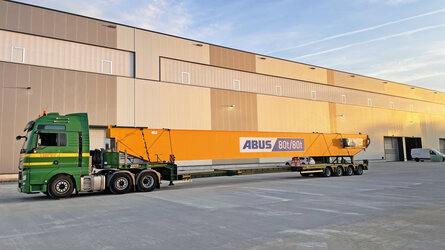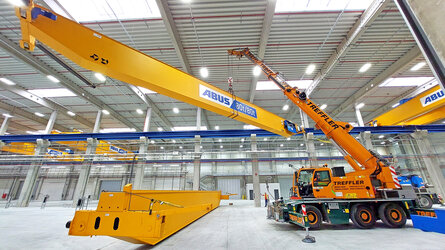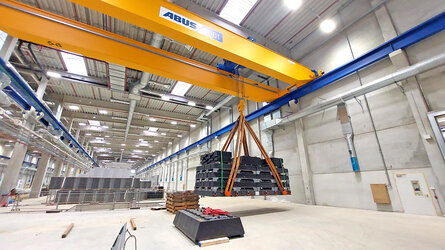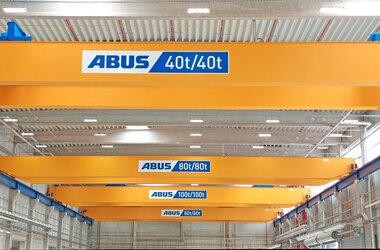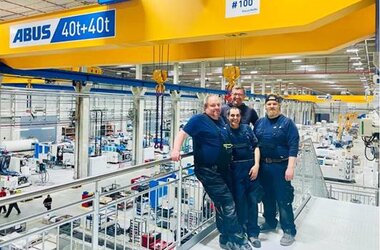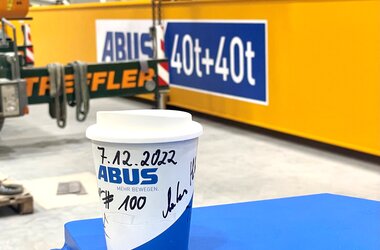Working together for top performance: 191 overhead travelling cranes in focus at KraussMaffei
It takes just a few days for ABUS Kransysteme GmbH's Gummersbach crane factory to build an overhead travelling crane for industrial use from steel sheets, cables and a rope. In a three-part series, we accompanied the creation of an 80 tonne overhead travelling crane through our factory, which will ultimately be installed 550 kilometres away in Parsdorf near Munich. Together with 106 other overhead travelling cranes and 25 jib cranes and HB light crane systems, it is part of a large order for KraussMaffei Technologies GmbH, one of the world's leading manufacturers of machines for the plastics processing industry. Part 1 of this series dealt with the delivery and preparation of the raw material and the assembly of the crane during steel construction. Part 2 then focussed on the painting and electrification of the crane. In this last part of the series, we show the transport and installation of the crane.
From the factory to the KraussMaffei doorstep
At ABUS, we plan our in-house, series production of cranes in our own factories depending on the delivery date, i.e. backwards from the day on which the crane is to be installed on our customer's site - in this case in the new KraussMaffei plant. Because of the dimensions of an overhead travelling crane alone - this one is over 22 metres long - it is clear that storing a finished crane for a long time at the manufacturer's would be extremely space-intensive and therefore expensive.
In view of the almost 200 cranes delivered to Parsdorf, it quickly becomes clear what an enormous amount of planning and coordination would be required by the project managers at ABUS and KraussMaffei in order to be able to deliver each crane on the right day to the right building on the 200,000 square metre on the outskirts of Munich. A double girder overhead travelling crane, such as this 80-tonne crane, is usually dismantled and transported on at least two lorries. One of the two main girders is loaded and lashed onto each articulated lorry, as well as the end carriages and the wire rope hoist on both.
The heavy transports are usually not allowed to drive until 10 p.m., so the motorway slip roads on the A4 near Gummersbach often flash yellow in the evening hours when overhead travelling cranes are shipped from here to all points of the compass. The whole of Germany and neighbouring European countries are supplied with cranes directly from Gummersbach in this way. The cranes are transported to Scandinavia, Spain and Poland pre-assembled - or even fully assembled in the case of smaller single-girder overhead travelling cranes - on low-loaders. Only beyond this and for overseas orders does ABUS supply the so-called Crane Kits. Here, all key components such as the wire rope hoist, the control system, end carriages and cables are placed in a freight container - together with a detailed construction plan for the main girders, which are then manufactured by selected partner companies in the respective country according to the specifications from Germany. In this way, ABUS Crane Technology can be found as far away as South America, Australia, Asia and New Zealand.
Construction of the 191 overhead travelling cranes at KraussMaffei
Once the overhead travelling crane has arrived at the customer's site, it doesn't take much to install it. An ABUS installation team usually consists of just two people, a lifting platform and a mobile crane with driver. The lorries are first unloaded on site and the crane is assembled at ground level. Thanks to the largely completed assembly in the Gummersbach factory, it is usually only a matter of bolting the end carriages to the main girder before the impressive lift of the overhead travelling crane is undertaken: a mobile crane lifts the overhead travelling crane, the install engineers then carefully spin and land it on the crane runway in the customer's facility.
In the case of double-girder overhead travelling cranes like this 80-tonne crane, the wire rope hoist now follows, which travels as a trolley above the two main girders. On smaller single-girder overhead travelling cranes, the trolley is usually located at the bottom of the main girder and is already mounted ex works.
Finally, all the outstanding components, such as current collectors or special equipment, have to be fitted on site before the crane is theoretically ready for use. However, before KraussMaffei is allowed to put its cranes into operation, a final acceptance test is required. An expert checks that the crane is in proper condition and tests all safety devices such as the limit switches at the end of the crane runway, the hoist limit switches that ensure that the load hook stops just before the top hook position and, of course, the overload protection device. For this purpose, a test load must be suspended from the crane that is close to the actual maximum load capacity of the crane. With an 80 tonne crane, this is another impressive work step.
After the relocation from the previous plant in Allach in the west of Munich to Parsdorf began at the start of 2023, production has running in the new facilities for some time now. Since then, 106 overhead travelling cranes from Gummersbach, together with 25 jib cranes and HB light crane systems, have been helping the workers to manufacture machines for plastics processing at world market leader level.
"Almost exactly a year ago, we were standing in bitterly cold production facilities at KraussMaffei's new site. The drafty, cold building site has been transformed into logistics, production and assembly facilities [...]. In general, once again big compliments to the site team for the fact that, despite all the adversities, everything went smoothly and was completed [...]. - Markus Huber (Project Manager at KraussMaffei)
- Markus Huber (Project Manager at KraussMaffei)
